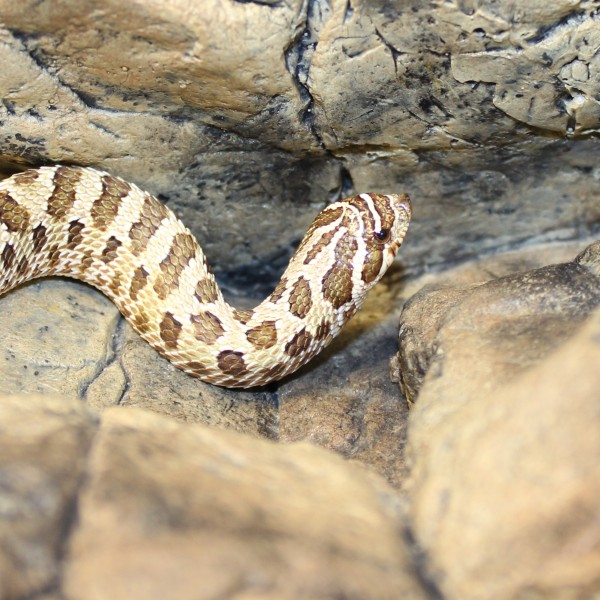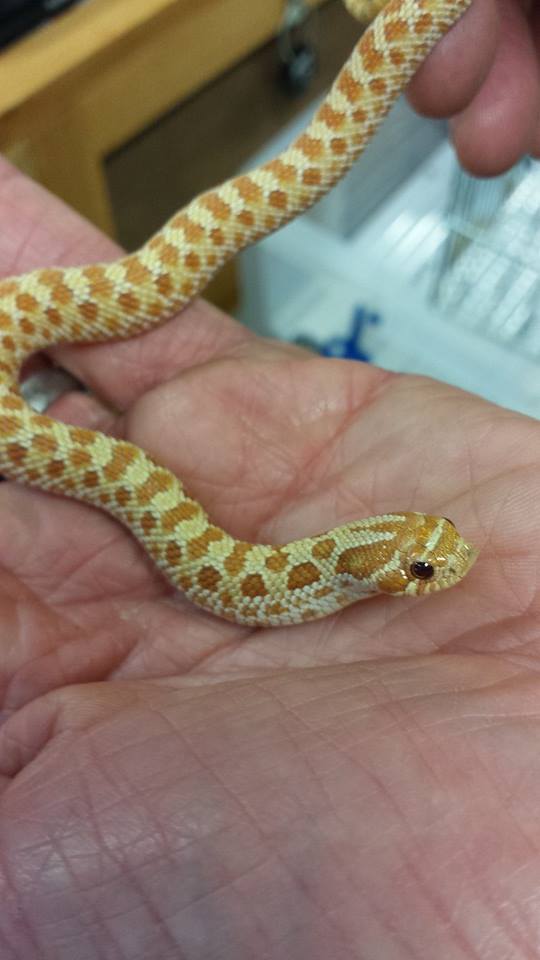Copyright 2021 Evolution Reptiles
All rights reserved.
Copyright 2025 Evolution Reptiles
All rights reserved.
All rights reserved.
Hognose snakes are very distinctive snakes, with their upturned nose. This aids digging in the soil in the search for the frogs and toads which are their natural prey. In captivity they readily accept frozen rodents. They are also mildly venomous, with the fangs at the rear of their mouth, but are not considered to pose any danger to humans. They have short stocky bodies – a 2ft long hognose can be as bulky as an adult corn snake. Females are larger than the males, growing to around 75cm (30″) while the males rarely exceed 50cm (20″.)
As with all snakes, a baby can go directly into an adult sized enclosure provided that there are plenty of hides. A good rule of thumb is that if the snake can cross from one side of the vivarium to the other without showing itself, you have enough hides! Despite their small adult size, Western Hognose snakes benefit from a 36″/90cm length vivarium, although bigger is always better.

Hognose snakes require a temperature gradient of 25°C to 30°C (77°F to 86°F) during the day. This can be achieved by using a deep heat projector and a basking light mounted at one side of the vivarium to create a warmer end of the vivarium. These should both be controlled by thermostats. At night the temperature should drop to around 20°C to 25°C (68°F to 77°F). Never guess your temperatures, always check them with a good quality digital thermometer.
Although it has always been assumed that snakes do not need UV lighting, it is always a good idea to provide it. Low output T5 UV tubes are now available that can mimic the levels of UV that they would be exposed to in the wild, and we have found that when it is provided they will definitely use it.
The snake will require quite a few hides in the vivarium so that it can feel secure. By having 2 or 3 in different areas, the snake will be able to choose the one at the best temperature. Plastic plants are also good to use, as these look very attractive in the vivarium as well as offering privacy. Real plants however are a poor choice, as the heat will kill them very quickly and the snakes will often dig them out of their pots.

Feed your snake one defrosted mouse weekly. The mouse should be no bigger than the largest part of the snake. Hognose snakes can eat mice their entire lives – starting off with pinkies as a hatchling and moving up in size as the animal grows. They can also be offered rats, hamsters, quail chicks and day old chicks to vary the diet as they grow.
As snakes do not use energy to warm their bodies (as mammals do) they need less energy to function. Resist the urge to feed your snake more often or oversized prey as this can lead to the snake growing too fast, which can result in the head of the snake not growing at the same speed as the rest of the body. Obesity can also be a problem. If a snake is overfed they have no reason to move around their vivarium and this is detrimental to their health.
The simplest feeding technique is to place the defrosted food in the vivarium near the snake and leave it to feed. The other way is to offer the food on some tongs or tweezers to the snake; they will often strike very quickly then constrict the mouse.
Hognose Snakes have a lot of character and are great fun to keep. They are easy to maintain and many more colour morphs are starting to become available!
Common Name: Western Hognose
Scientific Name: Heterodon nasicus
Location: Southern North America
Habitat (wild): Arid woodland edge, scrub, farmland
Captive environment: Tropical arid vivarium
Preferred temperature range: daytime hot spot of 30ºC under the basking light, background ambient of 25ºC, cool end of 20ºC. Temperature can drop to 15ºC at night.
UVB Lighting: 6% UVB strip lamp or compact – 12 -14 hours a day
Ferguson Zone: Zone 2
Substrate: Any dry substrate except sand
Lifespan: 10 to 15 years
Copyright 2021 Evolution Reptiles
All rights reserved.